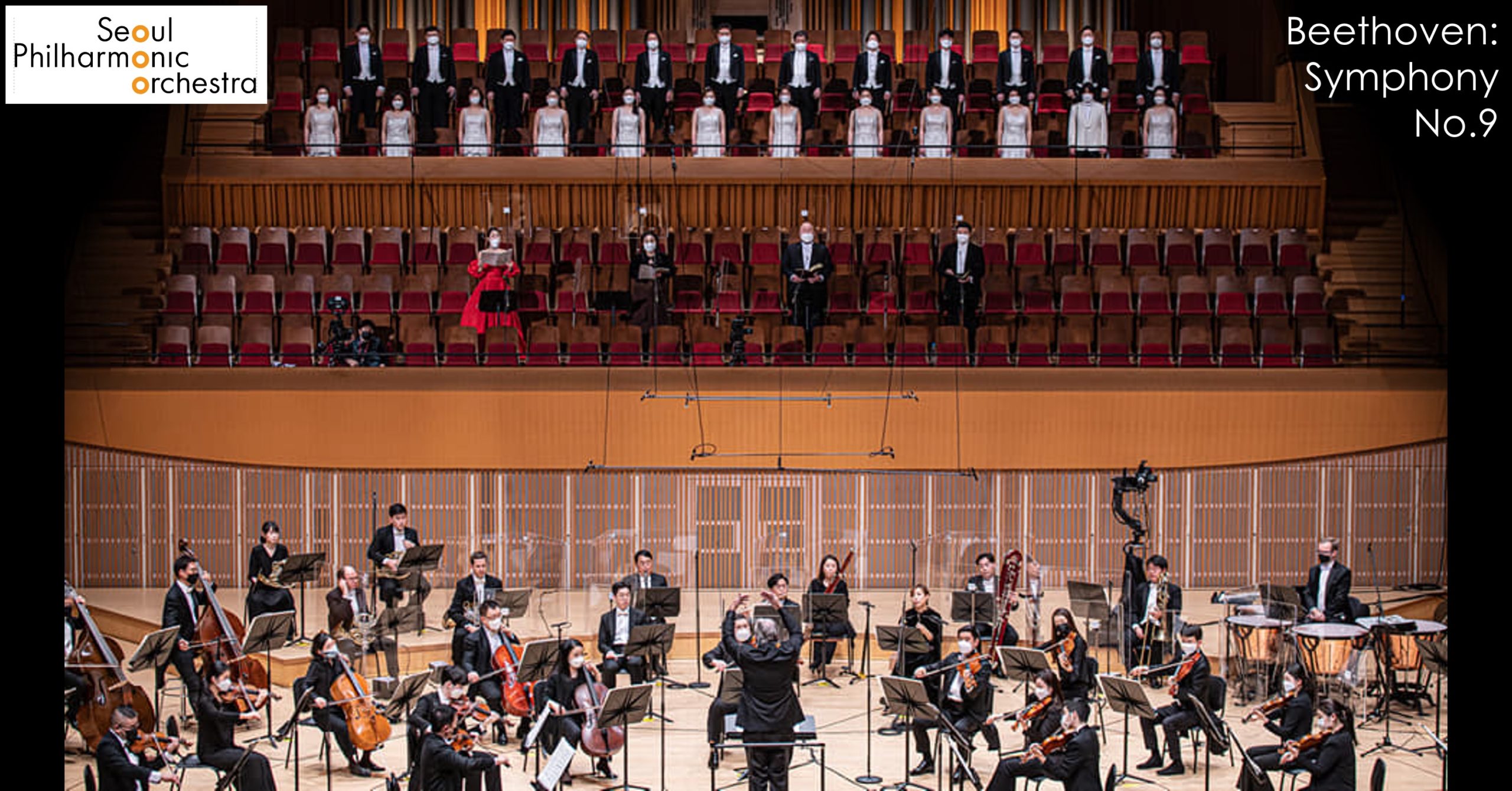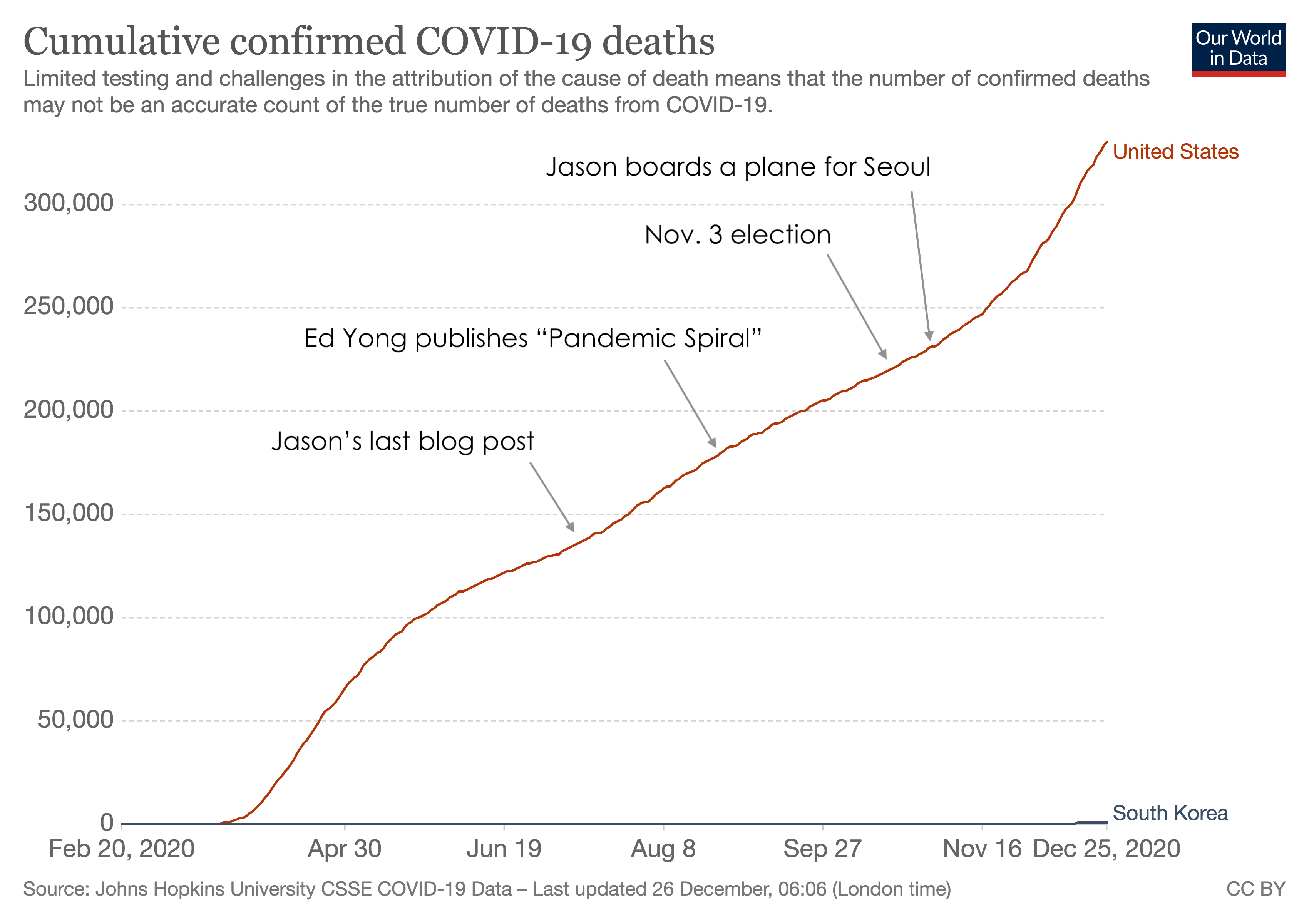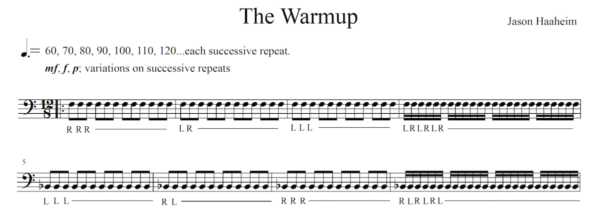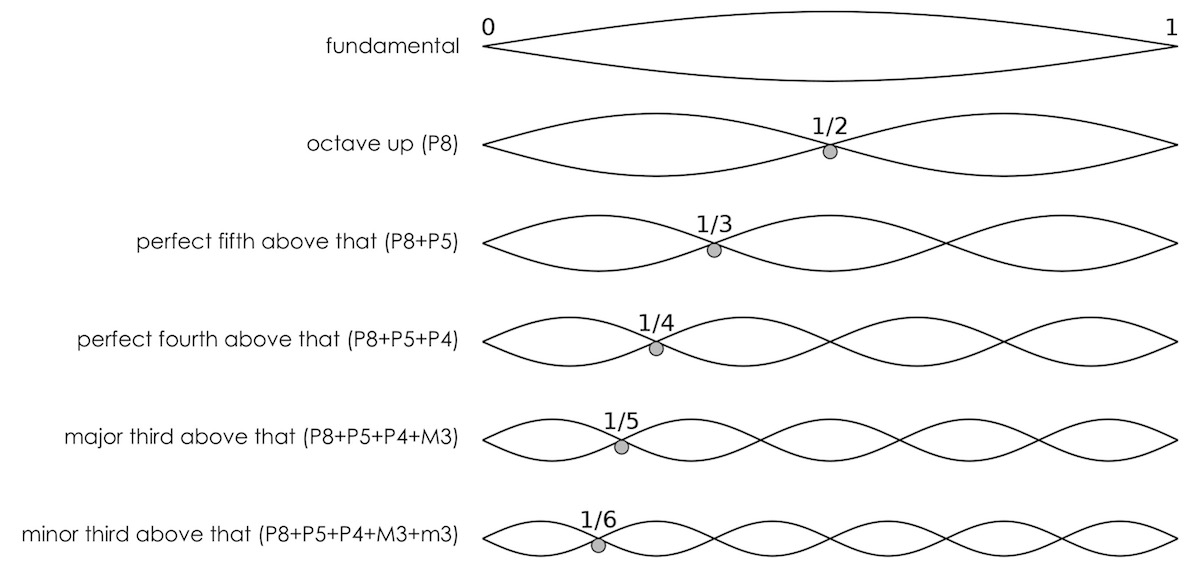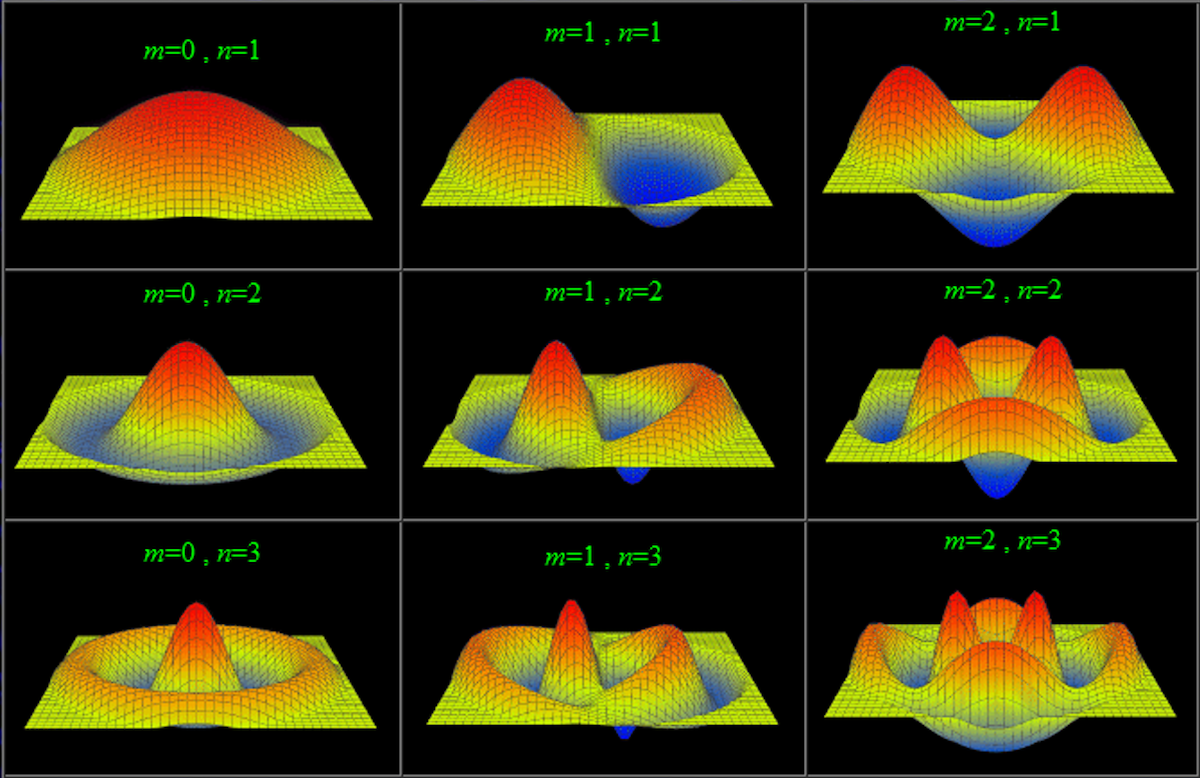On November 30th, I sat down to play on real timpani for the first time in 264 days. It was exhilarating. The concussion of each mallet resonated through the rehearsal hall. I welcomed the vibrations I felt in my fingers, hands, wrists, and arms. It seemed both familiar and new. The reverberations were recognizable, but they sounded to my ears almost like a forgotten dead language. I’ll admit I was misty-eyed within thirty seconds as the gravity of that moment began to sink in….
Likewise, on December 18th, I sat down behind timpani in a room full of real live musicians to begin rehearsing the first movement of Beethoven 9, my first large ensemble rehearsal in 282 days. It’s almost impossible to describe the complexity of those onrushing emotions: joy, elation, relief, fear, serenity, guilt, reconnection, disorientation…all in a blender while my ears were on fire and my mind was contemplating the gravity of that moment.
Two hundred and sixty-four days without safe access to timpani was by far my longest break in playing since I picked up my first pair of drumsticks in the fall of 1989, thirty-one years ago. Among the challenges facing percussionists and timpanists is that our gear takes up a lot of space. This means that many percussion and timpani professionals in big cities keep nearly all of their gear at the hall, where they’ll necessarily do the majority of their practicing. This is all the more necessary in a place like New York City, where even if I could afford an apartment sizable enough to comfortably fit a timpani practice studio, and could somehow play without riling my poor neighbors, the drums themselves are so large that they literally would not fit through the front door. Timpani at home is a nonstarter. So, since 2013, all of my gear has lived at the Met…which meant that when Lincoln Center shut down on March 12th, my life of practicing timpani shut down with it.
I was left feeling like the lyrics of that Joni Mitchell tune “Big Yellow Taxi,” which I first heard covered by the Counting Crows:
Don’t it always seem to go
That you don’t know what you got ’til it’s gone
Indeed. Exactly one year prior, I’d spent November 30th, 2019, performing Mozart’s Marriage of Figaro, capping off an exhausting week of rehearsing and performing Tchaikovsky’s Queen of Spades, Puccini’s Madama Butterfly, and especially Strauss’s Der Rosenkavalier (with Sir Simon Rattle conducting). Back then, I would’ve said “whew…maybe a little too much opera! Can we dial it back a bit?” Yeah…that sentiment is so 2019.
So it really was a heavy moment when I got behind real timpani again. Throughout most of the spring, summer, and fall, I had no idea when it would be possible. Then, I was incredibly fortunate to be offered an opportunity from the Seoul Philharmonic via Ed Choi (principal percussionist) to play a series of concerts in December and January as guest principal timpanist. I gratefully leapt at the opportunity. It was a no-brainer.
The gravity induced by the moments above has been due of course to the novel coronavirus — a sack of RNA surrounded by a bunch of fat that has rendered the U.S. a failed state. That gravity manifests in the way I can ride the subway here in Seoul without feeling like I’m in mortal peril. (Mask-wearing here is 100%.) That same gravity is evident in the looks of sympathy and bafflement from my new Korean colleagues; from the perspective of a sane, rational, developed nation that is effectively dealing with this pandemic, the scale of U.S. death and devastation is unfathomable. And that gravity was ultimately evident during our livestreamed performance of Beethoven 9, consolidating for me all of the ways in which the challenges of my ramp-up and reimmersion were not what I expected….
It’s a helluva backdrop for music-making. As Peter Dobrin wrote, “Everything we hear now…seems fraught…. Almost everything in the orchestral literature…suddenly seems about human connection.” And Dobrin wrote that in April. The vantage point is so much different from December. With the U.S. more bitterly divided than ever, the choral eruption in the fourth movement of Beethoven 9 — “Freude! Alle Menschen werden Brüder” (“Joy! All men shall become brothers”) — feels distinctly more aspirational than descriptive; more like a yearning for something we used to know than for something we can presently embrace.
For the last six weeks, I’d been reticent to post anything about these emerging plans with Seoul Phil. (Honestly, I’m still reticent even typing these words right now.) Part of me feels gross drawing attention to my own good fortunes amid such pervasive death and chaos. I’m acutely aware that through luck and privilege, I was able to escape the U.S. during its darkest winter in over a century. Moreover, I’m one of a very small handful of timpanists worldwide with the ability to safely rehearse and perform during this time; nearly everyone else is locked down, furloughed, or both.
But a number of friends and colleagues have urged me to get over this “survivor’s guilt” and write about these experiences, offering that some readers might want to live vicariously through the thrill of performing in such a bleak time, while others might be interested in what it’s like to ramp back up to perform one of the most iconic timpani parts in the entire repertoire after nine months away from instruments.
So, it’s for you folks that I’m writing this post. My ramp-up journeys through numerous themes, each massive in their own way, and each dizzying in their contribution to my experience of the eventual Beethoven 9 performance. And if you are in the position of having lost work, or you or your loved ones are sick, or you’re grieving another needless victim of this horrific pandemic, I am so so sorry. It should have never come to this.
Fighting “The Habituation of Horror”
On September 9th, 2020, one of the absolute best journalists covering the coronavirus pandemic, The Atlantic’s Ed Yong, published a feature entitled “America Is Trapped in a Pandemic Spiral.” In it, he catalogued many of the ways in which the U.S. has utterly failed in its coronavirus response, making the analogy “army ants will sometimes walk in circles until they die.” But it was his final stinger of the piece that really got me — the section titled “The Habituation of Horror”:
The U.S. might stop treating the pandemic as the emergency that it is. Daily tragedy might become ambient noise. The desire for normality might render the unthinkable normal. Like poverty and racism, school shootings and police brutality, mass incarceration and sexual harassment, widespread extinctions and changing climate, COVID-19 might become yet another unacceptable thing that America comes to accept.
I vowed that I absolutely would not “come to accept” the staggering toll…but of course, Yong’s writing was all too prescient: on the day he published that piece, the U.S. death toll was roughly 190,000. As this blog post publishes, the toll will likely exceed 330,000.
My last blog post was on July 19th. In it, I argued something which I believe to be self-evident — that we’re living through the most teachable era in human history for the necessity of expertise. It’s probably unproductive to retread ground like “maybe ingest bleach” or “slow down the testing”; suffice it to say, in March it was clear that Americans should be outraged by our government’s flailing pandemic response, and it has just gotten so much worse.
In retrospect, July 19th, 2020 really was a simpler time: it was before the worst case scenario of collapsing hospital systems running out of ICU beds and staff, with a Los Angeles hospital facing “so many patients streaming in that gurneys have been placed in the gift shop,” and 911 calls going unresponded because ambulances have nowhere to take patients. It was before the president was propagating the myth of a stolen election, now believed by a majority of Republican voters. It was before 18 state Attorneys General (40 percent of all AGs) and 126 house Republicans (64 percent of the caucus) signed on to a lawsuit inflating that myth by aiming to overturn legitimate election results, an act of cold civil war eroding the foundations of U.S. democracy. (As E.J. Dionne noted, “At least the Confederate secessionists acknowledged that Abraham Lincoln won the 1860 election.”) It was before the president began pardoning corrupt political allies and war criminals, and terrifying his staffers by plotting a coup in Oval Office meetings with conspiracy theorists. And it was before we were routinely losing over 3000 American lives every single day — a daily 9/11 superimposed across the holiday season.
And that is why, even though this is fundamentally a blog post about ramping up to play Beethoven 9 after nine months without access to timpani, I must acknowledge the surrounding circumstances. I absolutely refuse to habituate this magnitude of horror:
In that respect, my time thus far in Seoul has been almost radicalizing in how it’s pulled me away from the urge to normalize the tragedy. It feels like reverse anesthesia. If you squint really hard at that graph above, you might discern South Korea’s total death toll: 793. That’s not a typo, you read that correctly: 793 total deaths, in a nation of 52 million. More than four times that many Americans are dying every single day. (I feel obligated to note that even though South Korea’s recently rising Covid rates prompted the cancellation of several other planned concerts, their new daily cases only recently hit 1000, while the U.S. has been well over 200,000.)
To many of my new temporary colleagues here in the Seoul Phil, this comparison is literally incomprehensible. As Daniel Kahneman documents extensively in Thinking, Fast and Slow, human beings are inherently terrible at thinking logarithmically, and yet that’s what’s required to try to comprehend the U.S. right now from a South Korean perspective. The experience of U.S. life is nearly three orders of magnitude different, a thousand times more tragic. When answering “do you know anyone who’s gotten sick with Covid?”, I reflexively and exasperatedly spout “hundreds. I mean, not only that: I know at least five colleagues just at the Met who’ve died since March.” The questioner’s face turns ashen. They’re stunned, murmurings of condolences hanging impotently in the air. Of course I appreciate it. Their compassion is real and heartfelt. It’s just…it feels almost alien when I’ve arrived from a country that’s become so numb.
So I usually try to change the subject to something less dreary. But even still, reality intervenes: “How are things in your orchestra? Is it really true that the Met has furloughed you all without pay since April??” And in my head I’m thinking, “oh boy, more gravity, here we go….”
Precipitating Exile
On December 9th, the Met’s general manager Peter Gelb initiated a lockout against our stagehands (Local 1). Regarding the increasingly disastrous situation at the Metropolitan Opera, I’m going to let two others set the stage. In the New Yorker, Alex Ross assessed the current blackmail dynamics as follows:
The damage that performing-arts groups and working performers have suffered is more severe than we can measure, and years will pass before even a partial recovery takes hold. Union rights were already under sustained attack, and organizations may opportunistically use the crisis to degrade those rights further. The Metropolitan Opera, which furloughed around a thousand employees in the spring, has offered to resume sending paychecks to unionized employees but only if they accept long-term reductions in salary. Elsewhere, institutions have managed to avoid gutting their employees’ livelihoods.
Then, Daniel Barenboim:
In the United States the situation is horrific. Look at the Metropolitan Opera’s wonderful orchestra. It hasn’t been paid since March. How can all the rich people who put so much money into new productions not support the musicians who have given so much pleasure over so many years?!
How indeed. How is this possible? How has it come to this?? The immediate opportunism Ross noted above springs from the recognition that “the plight of the arts” is virtually no one’s highest priority right now. Unionized workers’ primary leverage is to deny their services (i.e., strike), but what does that even mean when force majeure has been invoked to indefinitely furlough you without pay? You can’t strike when you’re already furloughed. So amidst governmental chaos and a raging pandemic, it’s a perfect time to sneak in some contractual changes under the radar.
But this reckoning goes deeper: for years, unionized performing artists have been faced with a basic existential conundrum: how do you successfully negotiate contracts when the counterparty doesn’t necessarily care about the art form or institutional mission?
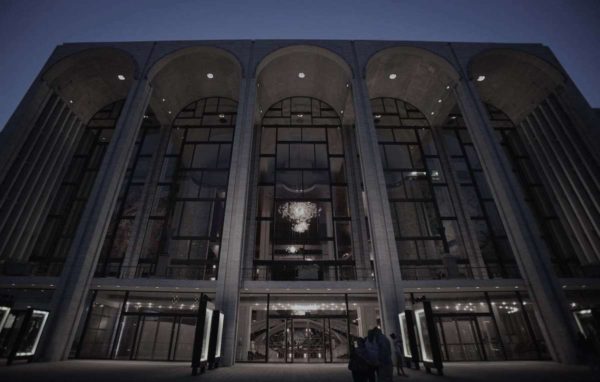
To be clear, it hasn’t always been this way. Drew McManus notes that from the passage of the 1913 Revenue Act onward, “there was a fundamental understanding that the money class would fund things like arts and culture…. Those involved at the time simply understood the one percenters of their era would pony up the dough.” This all worked well enough…until it didn’t. I’ve had conversations with Met Opera board members who lack the most basic understanding of non-profit organizations; when I was asked “why can’t you guys be profitable like Broadway?”, I had to restrain my snark while answering “because if we were, you wouldn’t get that sweet tax deduction for your charitable contribution.”
Complicating the vicious cycle, it’s these same board members who hire the executives to run places like the Met. Scott Chamberlain notes that Gelb’s talking points surrounding the current lockout “are a carbon copy of the arguments he made to force union concessions during the last Met labor dispute in 2014.” And as McManus clarifies, “You’ll know ‘bullshit expertise’ when settling old scores is being repackaged as ‘transformational change.’” Yeah…that’s not a plan. That’s not “vision.” That’s just bullshit.
In fairness, there remain conscientious arts leaders out there who do have vision, and who are working with their artists in good faith; I don’t envy their jobs right now trying to navigate the greatest existential shock to performing arts organizations since the great depression. But examples like the Minnesota Orchestra’s protracted sixteen month lockout in 2012 should’ve made it obvious that times had already changed: sometimes, managements and boards are acting in bad faith, and they actually want that fight. Sometimes, they view individual musicians as entirely dispensable cogs in a machine — a machine which, according to free market logic, is structurally inefficient. In this view, things like work guarantees and job security are an impediment to efficiency. In this view, efficiency is best achieved by converting a legendary orchestra into a freelance per-service ensemble. In this view, ideas like “artistic integrity” or “the public good” simply don’t exist.
Like congressional Republicans who ignore that they are oath-bound to defend fair elections and democracy, or firefighters who are also arsonists, it’s a fundamental problem when the nominal stewards of an institution don’t support its mission. Nevertheless, Minnesota’s example (and Atlanta’s, and Pittsburgh’s, and too damn many others) showed that when managements want a lockout, musicians can still harness the power of a transparent PR campaign to shine light on the bad faith, lack of stewardship, betrayal of public trust, and often outright lies. But it’s virtually impossible for orchestral musicians to accomplish this when hundreds of thousands of other performing artists remain out of work, the president is plotting a coup, and Covid-19 is killing a 9/11-worth of Americans every day. We’re facing a “great cultural depression,” but we’re also facing any number of other “great [fill-in-the-blank] depressions.” And I get it: even I, a tenured member of arguably the world’s greatest opera orchestra, have spent most of my time in the last nine months stressed about the United States’ pitiable debacle of self-inflicted mass death, and wondering whether it’s possible for anything resembling democracy to continue when the majority of Republicans reject the legitimate outcomes of legitimate elections. As a consequence, some of our most cherished arts organizations may never be the same due to decades of accumulated mismanagement and 2020-style sinister opportunism.
Which is all to say that my experience ramping up to perform Beethoven 9 in Seoul has been freighted with all of this gravity. And though this might seem like unrelated preamble, I assure you it’s been integral to my subverted expectations of these performing experiences. Moreover, we’re living through incredibly tragic times, and I don’t feel right putting my voice out there without continually acknowledging the suffering of U.S. performing artists specifically, and all Americans more broadly. I refuse to become fully numb — to habituate the horror. Anything less would be a betrayal of the fundamental ethos of Beethoven’s Ninth Symphony. And all of these things remain interconnected: my private musician’s nightmare of nine months without access to my instruments is a direct consequence of this horrifically mismanaged pandemic.
Which is also to reiterate: giving an enthusiastic “YES” to this Seoul Phil opportunity was a no-brainer.
From Disorientation to Elation
On November 14th, I woke up at 2:30 a.m. to begin my twenty-seven hour journey to Seoul. Throughout the preceding three weeks, I’d been watching the U.S. daily new Covid cases rocket past their second wave peak. The virus was everywhere, and I was incredibly anxious about traveling. Multiple times a day, I thought about cancelling the trip. Ultimately, I resigned myself to the knowledge that:
- I could not infect any fellow travelers, since I’d been quarantining for many weeks prior to departure.
- If I did become infected while traveling, it would be virtually impossible for me to spread the virus to anyone else, since South Korea was smartly mandating a fourteen day quarantine in a government facility for all incoming foreigners, and
- If I required hospitalization, I would be treated in facilities that weren’t buckling under the strain of a deluge of infected patients, thereby dramatically improving prognoses for treatment.
My stress began to significantly ebb as soon as I boarded the direct flight from JFK to Seoul. There were maybe forty passengers total. With a total capacity of 368, that meant the 777 was barely 10 percent full. With passengers sensibly spread out, I had an entire row to myself. I slept most of the flight.
Disembarking fifteen hours later at Incheon International Airport, I encountered an intake protocol which I can only describe as “aggressively sensible.” Fittingly, the very first thing I encountered walking through the terminal was a huge flatscreen running the “Wash Your Hands!” Baby Shark video on a continuous loop:
.
It might seem silly, but that moment really stuck with me: it’s a seemingly trivial marker of just how ubiquitous and thorough South Korea’s pandemic response has been. From that point in the concourse, I passed through probably six different checkpoints (variously with temperature checks, passport and visa inspection, and Covid testing), and finally arrived at the quarantine hotel via government shuttle; every single element of this process had been carefully designed to ensure minimum risk to all involved. Collapsing on my hotel bed, exhausted, I realized what I’d just witnessed firsthand: all it took for a country to stave off mass death is 1930s era technology and just the slightest bit of will and planning. It could be so easy.
Over the subsequent fourteen days of quarantine, I felt nearly nine months of existential anxiety begin to melt away. I was in a sane place. I was secure. Keeping light tabs on the news, it became harder and harder to accept that 250,000 dead Americans was really just a political choice — one aided and abetted by over 73 million American voters. It’s a searing truth that feels like the sun. It is burning and constant and I can’t stare at it too long without going blind.
Instead, I could actually start thinking about performing music again. For the next few months, my concerns could become “huh…what stick am I gonna use in this passage?” and “how much bulgogi am I gonna eat tonight?” I felt like I was living on a different planet. I did my best to ignore my rather intense survivor’s guilt; I refocused instead on the appalling state of my “hands” — my atrophied timpani chops.
As stated above, from March 12th onward I had no realistic way to maintain consistent access to timpani. Drum pads are better than nothing, and for a lot of snare drum work a pad is an essential tool of daily chops maintenance. But timpani are a fundamentally different animal; the sense of “touch” alone puts the instrument in a distinct regime of kinetics and technique. I wish I could claim otherwise, but I’ll confess that for much of the summer, my drum pad sat untouched. (Many times, my drum pad felt like a visceral reminder of all of the real playing that wasn’t happening…and wouldn’t be for a long time.)
However, this neglect was also a leap of faith grounded in my prior experience. Like sports teams in the off-season, MET Orchestra members must give themselves time to physically recover and mentally decompress. I received sound advice from colleagues at the end of my first season: take a healthy amount of time off. So I did. I went more than four weeks without touching a mallet after the final Carnegie concert of that first season. And my colleagues were right: it was scary, but my chops came back. Not only that: my chops came back better than before. The time off created crucial space which allowed me to think about how to practice smarter and more efficiently. I’d estimate that after a week of intense practicing prior to that 2014 fall season, I’d not only regained my lost ground — I’d started venturing faster into new territory.
But there’s a big difference between four discretionary weeks off and thirty-eight pandemic weeks of forced separation! From my mid-November perspective, I had no idea whether I could realistically expect the same kind of quick bounce-back, or whether something more fundamental had degraded.
I was right to be concerned…but for the wrong reasons.
So, I collapsed in bed the evening of my arrival in quarantine, contemplating the straightforward public health measures implemented by South Korea as I drifted off to sleep…and then found myself wide awake at 2 a.m. (Jet lag is brutal.) I got to work unpacking, and I promptly set up my custom-made timpani pad practice station:
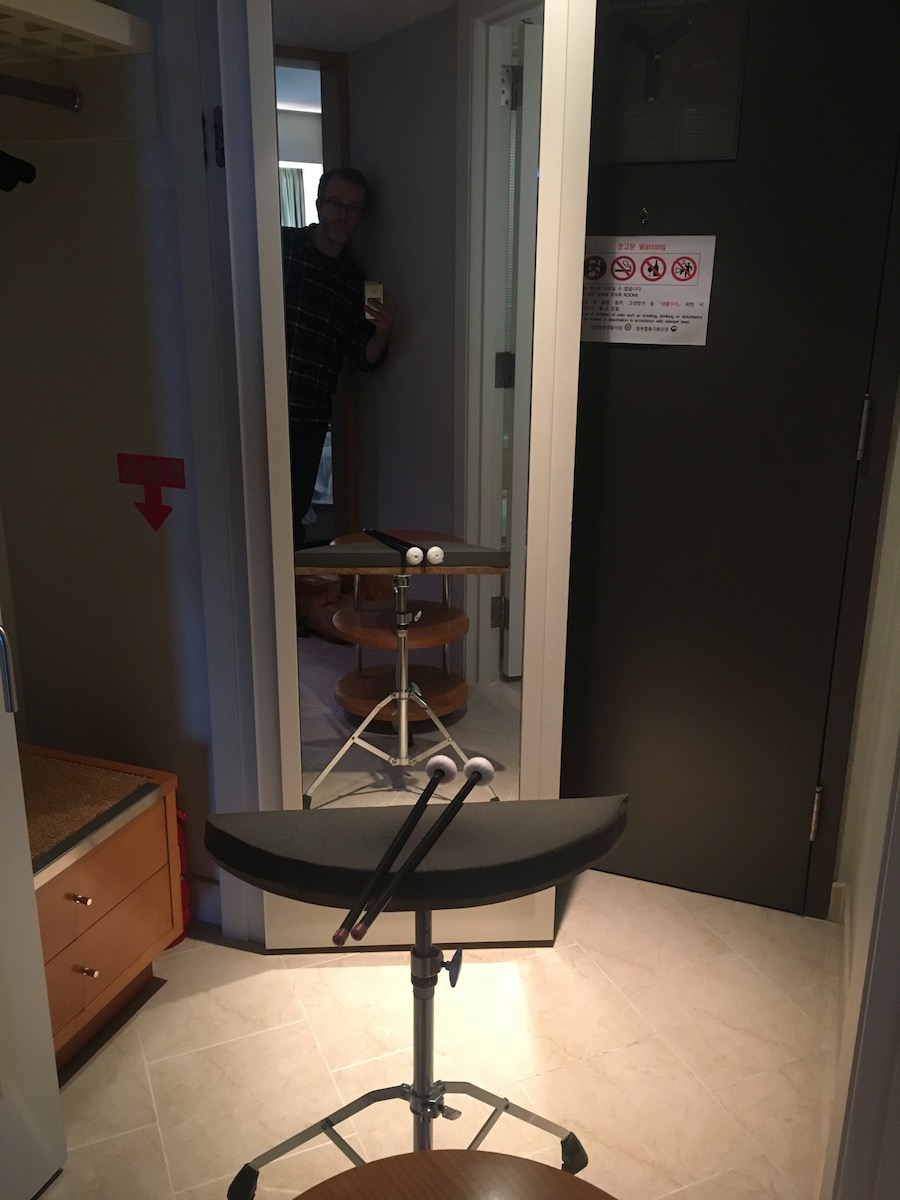
Unlike most drum pads, the pad I constructed uses a much thicker foam rubber which closely approximates the “feel” of a real timpani head with much springier rebound. I set to work on the first variation of what had become my de facto daily calisthenics for over twelve years:
The next thirteen days would incorporate plenty of extensions and variations on that warmup, but the core idea remained this: slowly, incrementally, and agonizingly track the threshold of my physical progress. I needed to quantitatively measure starting points for my chops, and then ramp those up as high as possible before my first rehearsal with the orchestra. You can see that first day’s practice journal entry here:
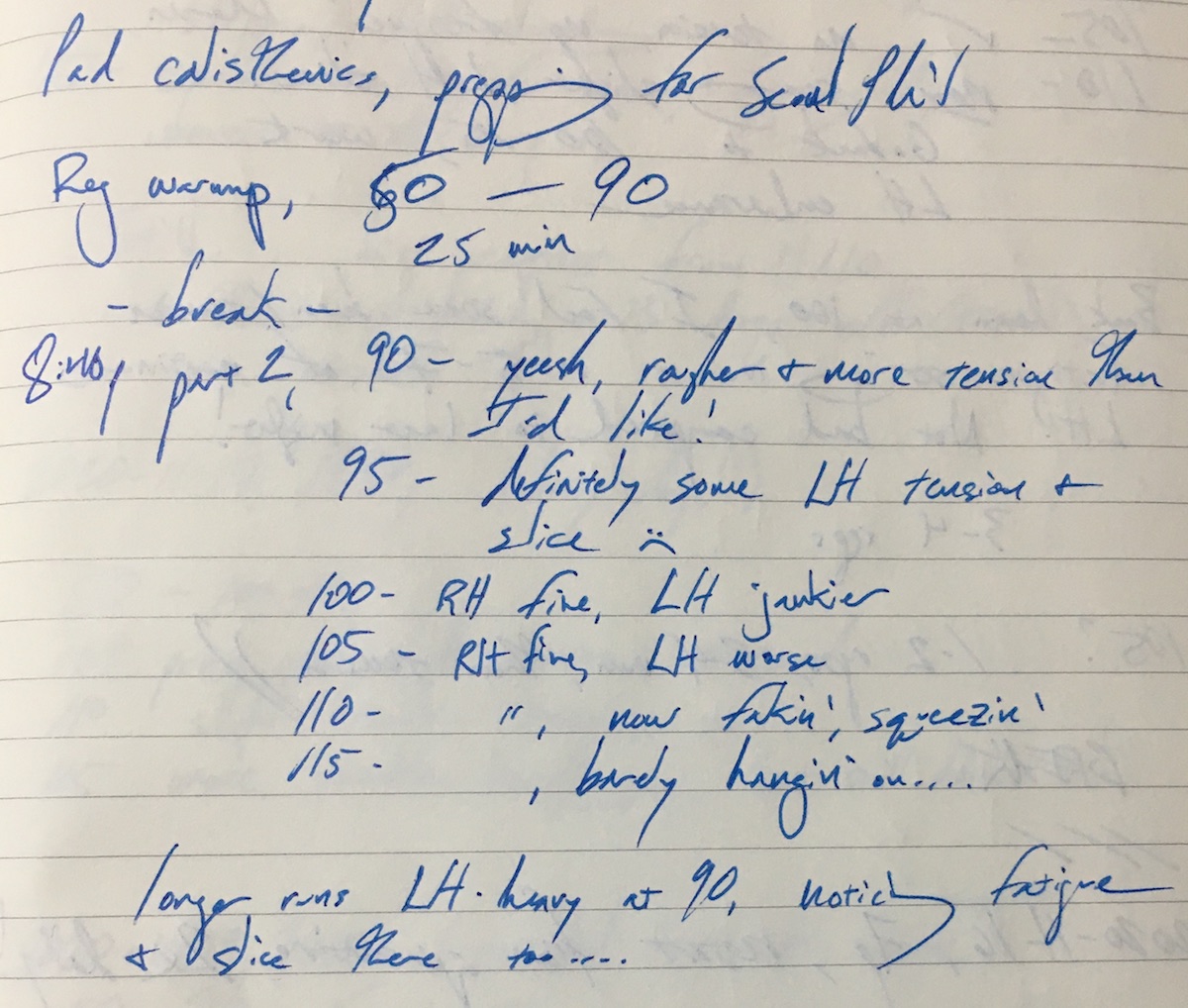
Since my handwriting borders on illegible, some of those key observations translate as “yeesh, rougher and more tension than I’d like!” And “barely hangin’ on…”
I’m not gonna lie: those first few sessions were rough. Scary. I didn’t know what I was dealing with, or what kind of improvement time frame I could realistically expect. (I mean, how could I? It’s hard to think of a comparable time for modern orchestras when a principal timpanist has lacked safe access to instruments for nine months.)
But by the third day, I was already starting to measure some noticeable improvements: the tempo thresholds for the onset of tension were rising, and the technique prior to tension-onset was much cleaner. I started introducing new variations in my warmup routine, targeting the very specific weaknesses I was noticing at different dynamic thresholds, particularly focusing on my non-dominant hand. (Knowing it’s essentially my rate-limiting bottleneck, I spent more than twice as much time independently targeting my left hand.)
By the sixth day, this was really starting to pay off. By the tenth, I was almost starting to feel cocky. By day fourteen — the day I’d be released from quarantine — I was no longer fearful to get on real timpani. I was eager.
But there was another surprise in store: my ears.
On Monday, November 30th, I left my Airbnb in the Hongdae neighborhood, boarded the Seoul Metro, and disembarked five stops later at the Sejong Arts Center, rehearsal-home of the Seoul Phil. Passing the temperature-checking Covid station, I took the elevator up to the fifth floor, flashed my keycard on the RFID console, opened the door, saw the timpani staring at me from across the room, and walked into a silent rehearsal hall for the first time in 264 days.
Working quickly, I was almost giddy as I uncovered the drums and unpacked my sticks. I laid out my tuning forks, my tuner app and metronome, and of course, my practice journal. I was about to sit down on the timpani stool, but then I momentarily paused. “This is an auspicious moment. I’m gonna want to remember this.” I snapped a picture of the setup:

I then sat down, tuned the timpani via their pedals, and began to play.
For those first few seconds, all I could really concentrate on was the physical sensation in my hands, and then reconnecting that physical sensation to the input from my ears. It felt so…new. But then a few more seconds went by, and I started to get confused: “wait…what the hell is going on?” I thought. “What is this? What are these notes? What am I hearing??!”
I had basically traveled back in time over twenty-five years.
One of the things I strongly encourage all musicians to do is play lots of mock auditions for people who don’t play your instrument and whose ears you trust. For timpanists, though, this often presents some interesting situations; I can’t tell you how many times I’ve heard some version of, “uh…cool…so…yeah…I think I liked it. Good rhythm and solid time and everything. But, like…what notes are those? What pitches are you even playing??”
And it’s a totally fair question! To the uninitiated, especially those who have not spent a lot of time listening to solo timpani, the drums can sound really weird. Why weird? Because of several specific aspects of physics and psychoacoustics.
In brief, regular sounds from “regular” instruments (e.g., a plucked cello string) produce easy-to-recognize pitches. That plucked string’s vibrations comprise sine waves defined by the “harmonic series” (1/1, 1/2…1/n). The unique “tone” we ascribe to any instrument (e.g., cello vs. piano) is really just due to the nature of the attack envelope, which of those sine waves are present, and how strong they are:
But timpani are not plucked strings! Rather, they behave according to something much more complex: Bessel functions. I’ll spare you the gory details (if you’re interested, Richard Jones has a thorough and excellent discussion of these issues on his site), but the gist is this: vibrating membranes do not generate a “sensible” overtone series. Instead, we get this mess:
The overtones generated by a Bessel function are virtually unrecognizable as a clear pitch. So, over centuries of trial and error, timpani-makers added differently sized kettles underneath the head. It turns out that a semi-constrained volume of air underneath a membrane will “baffle” its vibrations — the kettle takes the square peg of “insane overtones” and mostly jams it into the round hole of “sensible” harmonic series overtones…but “mostly” means there are still some residual “garbage harmonics” floating around.
For most timpanists working with good instruments and decent drum heads, the “garbage harmonics” are minimized and our ears do the rest — or rather, our brain’s acoustical processing does the rest. Human auditory perception is incredibly sophisticated, and a tremendous amount of filtering and signal processing happens before we’re even consciously aware of hearing a sound. Sometimes the filtering involves pruning away unnecessary information. And sometimes it involves adding necessary information. Timpanists’ ears need to do both: filter and enhance. (In psychoacoustics, this is called “interpolation.”) But this takes time and training. So, “what pitches are you even playing?” is a totally fair question if your ears haven’t developed the requisite psychoacoustical interpolation via practicing solo timpani for thousands of hours.
And evidently, those psychoacoustical interpolation faculties can atrophy! I was experiencing in real-time the “garbage harmonics” consequences of nine months without hearing live solo timpani. I was essentially traveling back in time twenty-five years to when I was just starting to play in middle school, trying to wrap my brain around using pedals to change pitches I was barely perceiving.
This was all extremely disorienting! It was like hearing something you recognize without being able to really discern it, like that Twin Peaks dream sequence (or excellent Simpsons spoof) when the actors recorded words backwards and then that was reversed and dubbed into the scene.
Luckily, I was noticing my pitch perception markedly improving by the end of that first session. And it was dramatically improved after the second session. By the middle of the third, I was feeling confident enough to “clear the heads,” a process of achieving the clearest possible aggregate tone by listening for minutely different microtones between different spots on the head and correcting the tension at each individual lug. By the fourth, I felt like John Wick: “my ears are back!”

It was time to really start shedding for the big one: Beethoven 9.
Happy 250th, Ludwig van
The coda from Beethoven 9 mvt. I is one of the most frequently requested timpani excerpts. In many ways, I’d been prepping Beethoven 9 since 2002, the first summer I really dug into it at the Aspen Music Festival. But in spite of having its numerous excerpts memorized for more than fifteen years, performing the symphony well requires experience and rehearsal. Thus arrives another irony: the only time I’d actually performed Beethoven 9 was thirteen years prior with a community orchestra in La Porte, Indiana. While many musicians will end up with humorous statistical gaps in their performed-repertoire experience, and while it’s even more of an issue when you spend so much of your time playing opera, I found it particularly hilarious to consider that my Beethoven 9 performance experience would span all of two concerts: the first, a humble gymnasium in north-central Indiana. The second, performing with the Seoul Philharmonic as one of the only timpanists in the world able to do so in the middle of a global pandemic. (Three days after Herr Ludwig’s 250th birthday no less.) Cool. Cool cool cool.
So, I prepared for the first rehearsal. Thoroughly. I did so according to the methods I wrote about before, where I’ll spend much more time studying the part and score away from the instruments than I will actually on the instruments. That said, I also spent a lot of time shedding on the timps! Regular readers will recognize the framework of highly targeted deliberate practice: a set of priorities ranging from higher to lower, with a clear idea of the weakest and/or highest-risk spots, specifically crafted exercises aimed at improving those weaknesses, and the ability to tailor my practicing based on constant feedback. I spent tons of time on just a few notes. I also did three complete play-throughs of all four movements in which I was listening on my headphones and playing along in real-time. And I did plenty in between.
Walking into that first rehearsal at Lotte Concert Hall, I felt prepared…or at least, as prepared as possible on the things I could practice, and the things I could visualize. What couldn’t I practice or visualize? The feeling of rehearsing. The feeling of what it’s like to play with other live human beings in real-time, hearing all the nuances of the sounds they’re making, and responding and adapting. (You can’t practice ensemble playing while isolated in a pandemic!) And that made me nervous: you can’t prepare for things you can’t anticipate.
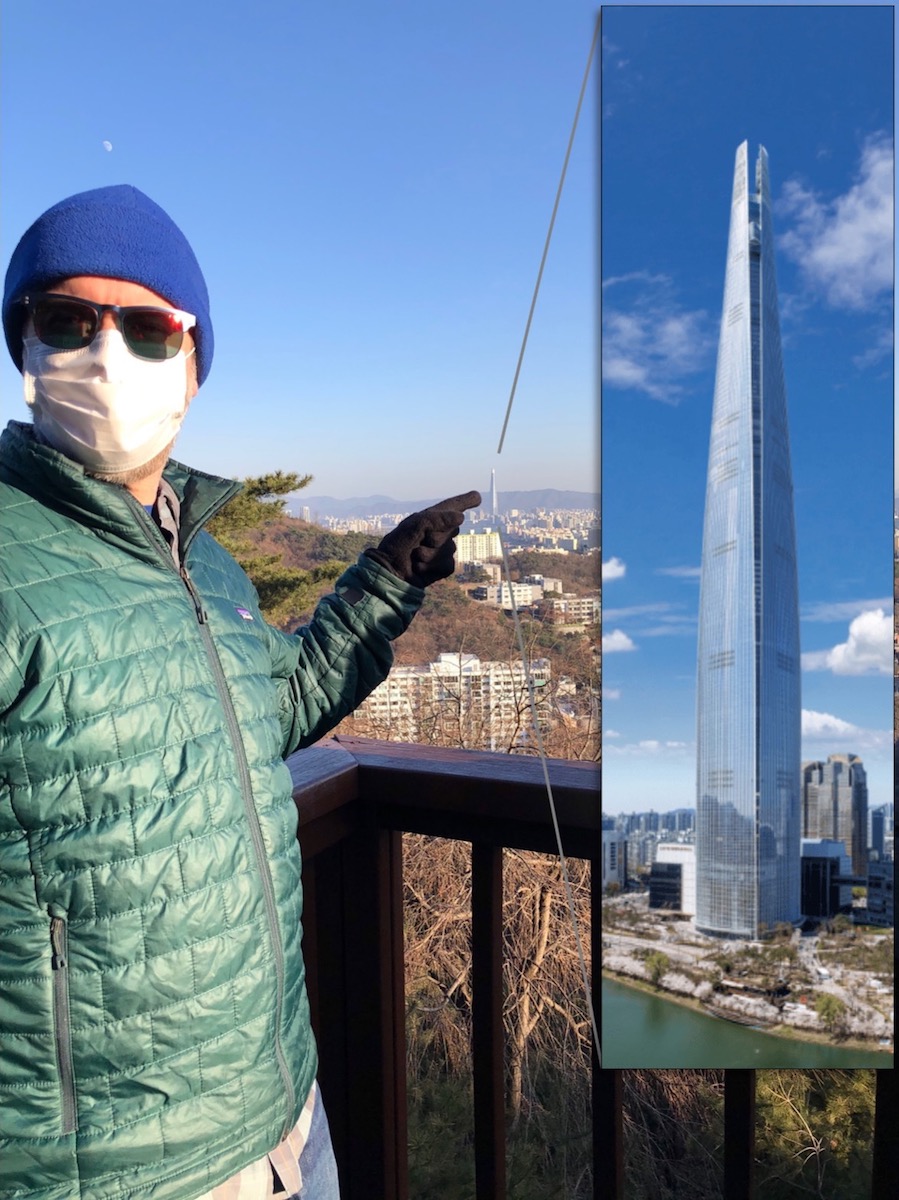
I arrived an hour early to that first rehearsal. I spent time warming up, clearing the heads, and listening to how various mallets sounded in the hall.
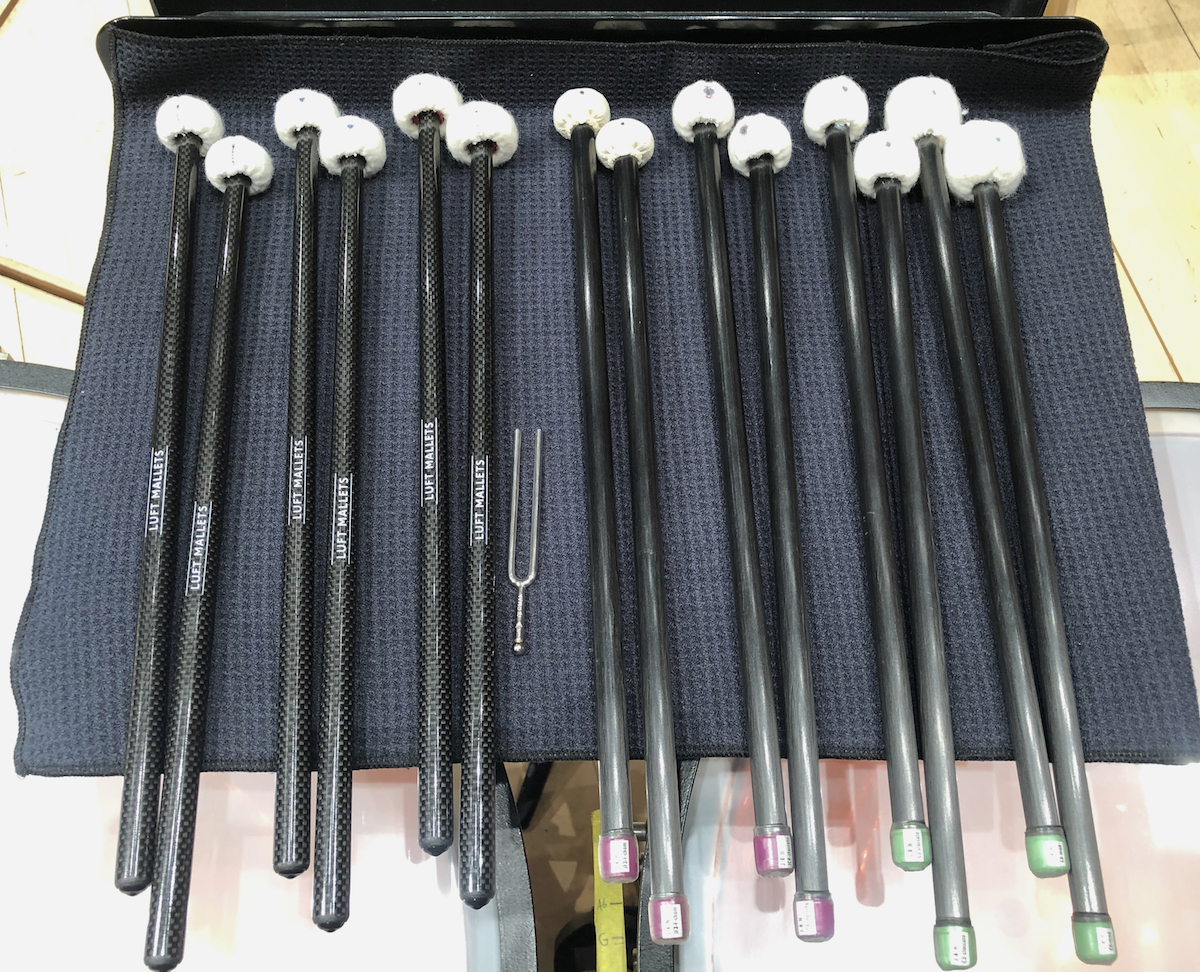
My friend Jeff Holbrook arrived (associate principal trumpet), playing first and only trumpet on this reduced-instrumentation B9 arrangement. We bantered. As musicians do. It was all feeling sorta…normal? Oddly normal.
Then the concertmaster stood up, signaled the principal oboe to give the tuning A, and we tuned. Maestro Markus Stenz stepped onto the podium, taking a moment to offer his gratitude for our ability to play this music in such an extraordinary time under such extreme circumstances. I wholeheartedly agreed when he said it was a privilege to be able to make music right now, especially when so many cannot. Beethoven 9 is often performed around Christmas, but this year we were among an extremely small handful of musicians worldwide able to carry on that tradition. (I thought about how it was especially fitting to rehearse “Ode to Joy” within three days of Sandra Lindsay being the first person in the U.S. to get a Covid vaccine.)
Maestro Stenz then paused: “okay…let us begin.”
With his downbeat gesture, the second violins and cellos began their sextuplets, horns holding their open fifth. The first violins then came in with their iconic descending line. I started to feel dizzy. The winds entered, and I felt dizzier. “What is even happening right now?” I thought, frantically realizing that my big entrance was quickly approaching. The next ten minutes were a total blur as instinct took over. I didn’t black out exactly, but I was also in a completely different headspace: I’d been bereft of live music sensory stimulation for nine months, and now I was getting it all at once. It was like a sonic tidal wave, and I was submerged not knowing which way was up or down or sideways. It was utterly disorienting.
I don’t think I embarrassed myself too profoundly in those first 10 minutes, but I can’t be sure. It was incredibly strange. Everything I was playing was coming from deeply-encoded muscle memory, the kind of myelination that’s a hallmark of years of deliberate practice. It felt like riding a bicycle while extremely intoxicated. Then, shortly before the famous coda, I started to feel like I was “sobering up.” As the coda began, I remember thinking, “hang on…I know how to drive this thing!” My awareness stabilized, and my senses normalized. Driving the movement home with the coda — one of the most famous timpani excerpts ever — was pure elation. One big difference between my music career and my nanotech career? I never cried happy tears when returning to my cubicle.
“It’s All In Your Head”: Subverted Expectations
For seven years, I’ve been performing live on camera with worldwide audiences numbering in the hundreds of thousands, so I didn’t expect our Seoul Phil livestream to feel too much different than those prior Met Live in HD experiences. I was wrong.
I’ve been reflecting on those subverted expectations for over a week now. As I alluded to above, I think the reasons this performance ended up feeling so different are multilayered and complex. But the shortest answer might be this: it wasn’t my hands that had atrophied the most over those nine months, it was my mind.
Cultivating mental discipline for peak performance is a requirement familiar to all musicians, all athletes…really anyone who has to perform under pressure. The peak performance state of mind is highly focused but broadly hyper-aware. You’re very cognizant of the passage of time in a musical sense, and the rhythms occurring therein, but you also develop the ability to stay “in the moment.” You’re free from the distracting chatter of an inner monologue. Past and future sort of dissolve, and all that matters is the ironically “timeless” present. This present-focused awareness helps prevent you from getting too “in your head,” dwelling on past mistakes, or dreading tricky passages to come. Up until last March, I’d gotten so used to routinely summoning this very calm inner state that I took it for granted.
But during our December 20th Beethoven 9 livestream, my “head” was hyperactive.
I was frankly unprepared for the mental aspect of this reimmersion. I was really out of practice! And in retrospect, that shouldn’t be too surprising — I’m not sure how one would simulate in advance the mental effects of a nine month pandemic hiatus. It might have helped to ramp up more slowly, on a less compressed rehearsal schedule. (I sort of went zero to sixty, and that “whiplash” likely contributed.) It also might have helped to know in advance that I should expect this “heady” aspect of reimmersion. (That’s part of why I wanted to write this post, since I imagine many other musicians may contend with similar reimmersion experiences in the later half of 2021.)
But I think there’s a key in terms of the nature of my mental hyperactivity during the Beethoven 9 livestream: it wasn’t just a bunch of self-trash-talking. Many musicians struggle with this sort of inner monologue demon, but that wasn’t what was occupying my bandwidth. Nor was it stressing about the next lick, or the next page, or the next movement; as noted above, I actually felt quite prepared. While it’s true that when the cameras turned on, part of my brain shouted “holy shit! You’re performing live again!”, that adrenaline surge actually faded fairly quickly, and I was reasonably pleased with how the performance went overall.
Rather, my mind seemed unable to stop exploring the high-gravity implications of this masterwork being performed at this particular juncture in 2020. Relating to my overall narrative above, I couldn’t stop thinking about how the gyrations of the D minor first movement felt so much like the year we’ve collectively experienced. The repeated fortissimos at rehearsal [K] felt like the relentless pummeling of the news cycle — just when you thought it couldn’t get worse, WHAM! It hits you again. Beethoven keeps this going a punishingly long time, and it just starts to feel like “there is no bottom.”
The fourth movement famously begins with a cyclical recapitulation of themes from the preceding three. Beethoven reflects on his previously-composed themes in real-time, variously shifting between them before settling on the irresistibly famous “Ode to Joy” melody. But even Beethoven’s meta-overview seemed to powerfully connect to my experience of 2020: while I was discovering that the primary challenge of the performance was not physical but mental, I was simultaneously coming to appreciate that the greatest challenge of getting through 2020 has likewise been wrestling with my own mind. Obviously, for anyone who’s contracted Covid-19, the physical struggle is very definitely real. But I think it remains an open question how we’ll individually and collectively work through the mental and emotional trauma imposed by this era.
And in an even larger connective sense, one of my previous posts described how refining “mental representations” forms the true core of any deliberate practice. Anders Ericsson essentially argued that this was the primary goal, and that all requisite physical activities were really just a means to that end. The primary challenge lives in your own mind. That has been my experience of deliberate practice. That was my experience of the Seoul Phil Beethoven 9 livestream. And that has been my experience of 2020, where nearly every single day has felt like a battle to assert my own connection to reality, facts, and science in the face of a relentlessly gaslighting onslaught, bludgeoning us all like repeated D minor fortissimo hammers, leaving us unsure whether there even exists a fourth movement, or the key of D major, or simple joy.
The Next Couple of Months: An Ode to Survival
With all of those gravity-inducing masses swirling through my hyperactive head like the time-lapsed orbits of dense planetoids, I had to expend an inordinate amount of mental energy to get through the concert “unscathed.” That mere seventy minutes of Beethoven left me feeling more exhausted than those 256-minute-long Rosenkavaliers Sir Simon had been conducting only a year prior. But my god it was so worth it. I’m thrilled to have had the opportunity. I’m grateful to Ed Choi for inviting me, and it was a blast rocking out in the “battery” with Jeff on trumpet and Scott Verduin on cymbals. Here’s me veritably beaming after the performance:
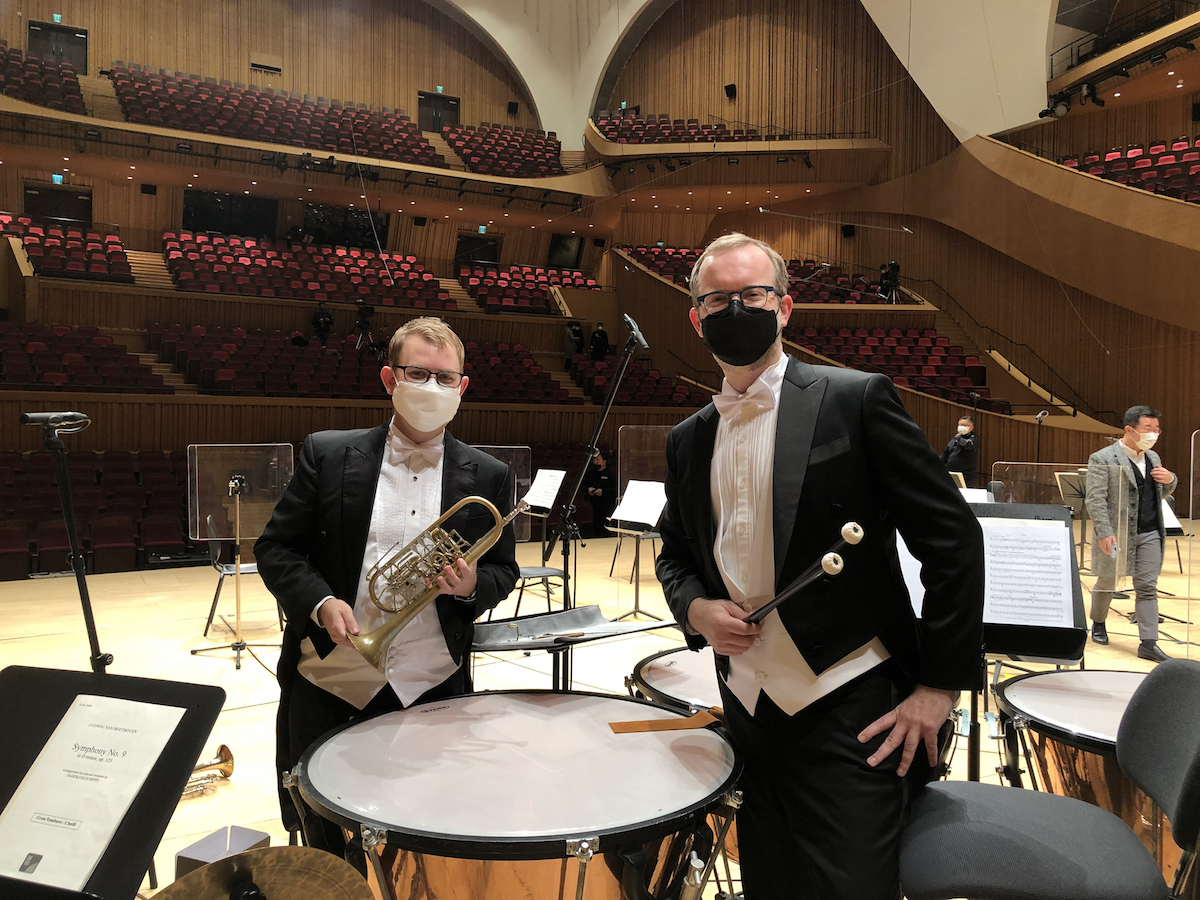
The full concert isn’t yet posted on the Seoul Phil youtube channel (when it is, I’ll link to it here [update: the full 4th movement is viewable here]), but friends and family documented some snippets. Here’s some choice timpani action from the second movement scherzo:
.
…and here’s the big arrival, “Ode to Joy”:
.
I wish it all could be as simple as that, a nice happy ending. I know it isn’t. We are nowhere near out of the woods, either with the coronavirus, or with ourselves as a deeply flawed nation fighting to live up to our purported ideals. It remains a fundamental irony that these American ideals have enabled modern South Korea; it would be a radically different nation without the U.S. military safeguarding the DMZ. And yet, adding another element of tragic gravity to the sphere of public health, it can seem like the “child” is the one modeling good pandemic behavior for the “parent.”
When coaching timpanists in lessons, I’ll often repeat the kind of advice that usually worked well for me: “stay focused and present in this moment. Don’t worry about the past or future. Focus on the performance right now.” As mentioned above, that very Jedi-like approach is a huge aspect of performance psychology. But even in the Before Times, when I was more adept employing it for practicing and performing, I struggled with it in other areas of my life. I still do. Part of me wants to just fully detach from the stateside anguish, ignore the news, gorge on bulgogi, and live life to its fullest until mid-February. But another part of me intercedes like Brad Pitt’s character in The Big Short:
.
…in my case saying, “the music party’s gonna end pretty soon, and you’ll have to go back home. Don’t get too caught up in the fun!” As I wrote above, “Freude! Alle Menschen werden Brüder” (“Joy! All men shall become brothers”) feels distinctly more aspirational than descriptive. But I also ask myself this: “what choice do we have but to aspire?”
After the longest break I’ve ever had in playing since I picked up sticks, I was able to come back to it…and it was still there. Eventually. After wiping off the physical dust and scraping off the mental rust, my playing resuscitated, and this should be a fundamentally hopeful message to anyone who is or will be going through something similar. It’s definitely been reassuring to me, and a testament to the fundamental resilience we can experience when we put in the time well. Deliberate practice investments are very durable. Perhaps collective reinvestments in our public health, social fabric, and commitment to fact-based reality can be durable as well.
Beethoven’s libretto also poses this question: “Ihr stürzt nieder, Millionen?” (“Are you collapsing, millions?”) With a worldwide Covid death toll surpassing 1.8 million, the answer is numerically “yes.” But he also counsels “Seid umschlungen, Millionen!” (“Be embraced, Millions!”), with the final text of the entire symphony exclaiming “Freude, schöner Götterfunken” (“Joy, beautiful spark of Divinity”). It’s as if Beethoven was writing for us now in this moment where, after so much darkness and strife, there’s a light at the end of the tunnel. In my mind, I was almost hearing the chorus sing “Impfstoff, schöner Wissenschaft” (“Vaccine, beautiful spark of Science”). Here is that final text as seen and heard from my “timpani cockpit view”:
May we all have a more joyous 2021.![]()

